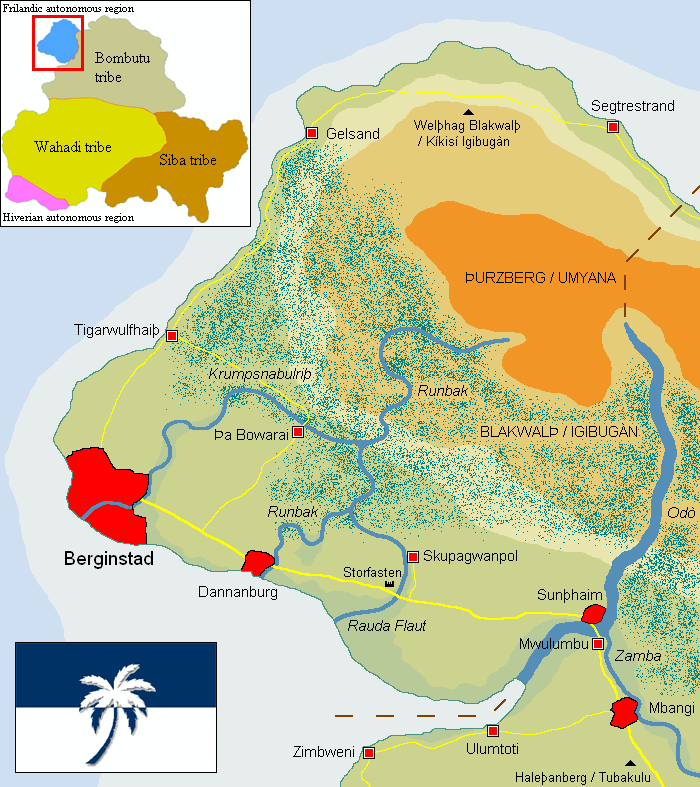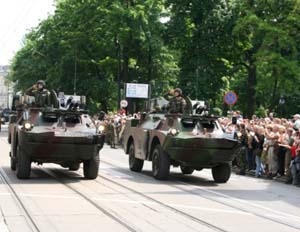  Frilandic KumangaGeneral information Frilandic Kumanga is an autonomous region of the African country Kumanga Yala, west of the Od˛ river, bordering the Bombutu tribal territory. It does not belong to Friland but it was founded by Frilanders, who make out the majority of the population in this region. For this reason, the area is usually called "Frilandic Kumanga", although its official name is Flauthrusfel■ ("Hippo Field", Kumangan: Shamba Kiboko). The region is about the size of Luxemburg. Two-third of the area is made up by mountains, barren plains and impenetrable jungle, making it sparsely populated. For those who would like to visit the area: after landing on the national airport in Port-de-Vivre you can transfer to a smaller plane to Berginstad. From there express buses regularly drive to other places or you can rent your own car.  Government The regional parliament (Buds■ing or "District Assembly") is led by governor O■alhild Raudasduhter. Despite its subordination to the national parliament, the Buds■ing has in practice more influence in the region than the national government, an unstable presidential democracy. In the national parliament the Frilandic minority is represented by the LFK, a party that strives for independency or unification with the Kingdom of Friland as an overseas territory. The region has its own media, jurisdiction and laws, even though these are subordinate to the Kumangan constitution. It also has its own flag (the blue-white of Friland combined with a Kumangan palm tree) and the Frilandic Skat is an accepted currency besides the Kumangan Owˇ. Population Frilandic Kumanga has about 90,000 inhabitants (3% of the total Kumangan population) and consists of Frilanders (85%), people of mixed heritage (7%), Bombutu's (5%) and other ethnic groups (3%) Due to the isolationist nature of the Frilanders, the identity of the region has remained largely Frilandic. Especially in Berginstad, Dannanburg and in the inland villages. Frilanders who are more open to other cultures, can mainly be found in the border town Sun■haim and in the Bombutu city Mbangi, where the Frilandic and African culture are in much stronger contact. Language and religion About 90% of the population speaks Frilandic (mainly Kumangan Frilandic) as its first language, 8% Kumangan (mainly Bombutu) and 2% other. Many children are being raised bilingual, with Frilandic as first language and Bombutu as a second language. Kumangan French is also still frequently used as a universal language. The most important religions are Ferna Sed (70%), Islam (6%), Catholicism (4%), nature religions (4%) and other (1%). 15% of the population is atheist. Culture Most Frilandic Kumangans regard their autonomous region as an overseas, tropical part of Friland, which should actually belong to the European motherland instead of Kumanga. Because of this, the culture of this area is still closely related to that of Friland. Although African influences can definitely also be found, like for example in the local cuisine and architecture. Besides most Frilandic holidays, "Stiftjarsdag" (Founder's Day) is celebrated each year on August 4, the birthday of Inghar Landmanssun, founder of Frilandic Kumanga. This is because the exact date of the foundation (1620) is unknown. On this day historical parades are held and the people eat ndolÚ (stew made of bitter leaves, nuts and fish/goat meat) with fufu (tuber pasta), a traditional African dish that is called "blad me■ hnutan ainput" (leaf with nuts stew) in Frilandic. This is the first dish that the Frilandic colonists ate on Kumangan soil, after this was offered to them by the Bombutu that came to greet them. The region is also known for its adventure movies and nature documentaries, which are very popular because of the beautiful landscapes and African flora and fauna. Famous writers from the area are Tishelm Wargssun and Kungun■ Dagmersduhter. Police and militia troops
Although the protection of the area is a task of the Kumangan government forces, the region has its own (private) militia troops; the Frilandisk-Kumanganiska Landwar ("Frilandic Kumangan Land Guard" or FKL). This because of the persistent attacks of Ogunti and Olodumare rebels, against which the Kumangan government forces can do very little. However, the FKL is controversial because in its diligence to keep rebels out of the area, it checks pretty much everyone "who doesn't look Frilandic," resulting in regular accusations of discrimination. Another point of criticism is that the FKL only takes orders from the Buds■ing, which the Kumangan government considers an undermining of its already low authority in this region. The FKL played an important role in the Second Kumangan Civil War, in which it cooperated with the government army in the struggle against Ogunti rebels. In this period Friland secretly supplied the FKL with better training, weapons and heavy material, like armoured vehicles and helicopters. Mostly of Russian origin and outdated, but nevertheless very effective in the struggle against lesser equipped rebels. Besides border guards and mobile vigilante patrols in off-the-road vehicles, the FKL also has two well-trained, heavy fighting units: the Laujanferhaup ("Lion Battalion") and the Nashurnferhaup ("Rhino Battalion"). History Frilandic Kumanga was founded in 1620 by Inghar Landmanssun as a Frilandic trading post. From there it developed into a dwarf state where merchants, explorers, gold diggers and other adventurers settled. When the rest of Kumanga became a Hiverian colony, Friland declared the little state to be its protectorate, to shield it from Hiverian invasion. However, the region never formally became part of the kingdom. In 1961 Hiveria pulled back from Kumanga and the country became independent. Due to heavy international pressure, Frilandic Kumanga also had to join this new state, but it did manage to keep a high degree of autonomy. The last few decades there is much unrest in Kumanga and there have been multiple coups and civil wars. Today the vulnerable democracy is still under serious threat by radical Islamic Olodumare militias and Ogunti rebels. Local authorities, the police and the army are being bribed, which allows the rebels almost free operations in most of the country. Not only against their political opponents but also against the European minority, which they associate with the colonial period. The Frilandic and Hiverian autonomous regions are regularly startled by organized attacks, against which the (often corrupt) government hardly acts. Because of this, the tensions have risen to such a level, that there is much mutual distrust between the different population groups of Kumanga and citizens retreat behind walls, fences and armed vigilante patrols. As a result, the tribal areas and autonomous regions of Kumanga have lost their faith in the national government and are virtually ruling themselves. Despite this, the people continue to have hope for the future, and during the last couple of years much progress has been made in bringing the different population groups closer together. More information: general history of Kumanga.  Settlements:
Settlements:Berginstad ("City of queen Bergin", Kumangan: Ilubergi) The capital of the Frilandic Kumanga region. It's a compact city with many high-rise buildings, which, despite its only 50,000 inhabitants, give it the aura of a big city. Dannanburg ("Firburgh", Kumangan: Atokigi) These days mainly known as a seaside resort, but originally there was a wooden fortress here that guarded the bridge over the Runbak river. Because the fir tree is not native to Africa, the name probably refers to a similar-looking indigenous tree species. Sun■haim ("Southham", Kumangan: IlÚgusu) The gateway to Frilandic Kumanga. Sun■haim lies on the border of the Frilandic region and the tribal lands of the Bombutu, making it a hub of trade and cultural exchange. Ůa Bowarai ("The Buildery", Kumangan: Gomozane) This village lies in a fertile area on the edge of the jungle, giving it an important role in the food supply. Tigarwulfhai■ ("Hyena Heath", Kumangan: Tsagulu) Wedged in between the jungle, savanna and the ocean, this little village is especially interesting for hunters, fishermen and people who enjoy rugged nature and wild animals. Skupagwanpol ("Crocodile Pool", Kumangan: Kwaniza) "Skupag" (scale lizard) is the Frilandic word for crocodile, which are plenty in this marshy area. Nice for tourists, but less nice for the villagers, because almost every year a couple of them fall prey to these reptiles. Gelsand ("Yellow Sand", Kumangan: Kunongo) This little fishing village is an important stop-over on the long road that leads around the Ůurzberg. It has a notorious truckers bar, gift shops and a casino. Segtrestrand ("Palm Beach", Kumangan: Umabulu) The most tranquil and isolated village of Frilandic Kumanga, where the waving palm trees, the azure water and the pearly white beaches attract many rich tourists. (Bombutu settlements) Mbangi (Frilandic: Hanapwik = "Hempwick") Important trading city on the Zamba river and a crossroad of cultures. It's a dangerous, but also very interesting city with many rugged bars and a brimming nightlife. Zimbweni (Frilandic: Gasthaim = "Lodging") Dormitory town of which most inhabitants work in the city of Bushanti, further to the south (not on the map). Mwulumbu (Frilandic: Hamarwerk = "Hammerwork") Small, but atmospheric town on the road from Sun■haim to Mbangi. Mainly known as a pleasant stop-over where one can eat well and cheaply spend the night. Ulumtoti (Frilands: Barn■urp = "Childsville") This village is regularly visisted by linguisticians because a very old Bombutu dialect is spoken here, which can perhaps tell more about the origin of the native languages of Kumanga. Other locations: Storfasten ("Great Stronghold", Kumangan: Amasabi) Fortress that was built in 1890 to guard the bridge over the Rauda Flaut. In 2008 it was put to new use to defend against Ogunti rebels, who regularly perform attacks on civilians. Hale■anberg ("Mountain of Heroes", Kumangan: Tubakulu) During the Fourth Frilandic-Hiverian War (1881) Bombutu warriors and Frilandic-Kumangan militia forces gained a great victory here over the Hiverian colonial army. Every year Frilanders and Bombutu gather here to collectively remember this moment. Wel■hag Blakwal■ ("Wildlife reserve Blackwood", Kumangan: KÝkisÝ IgibugÓn) Safari park where tourists can see wild animals in a safe way. Blakwal■ ("Blackwood", Kumangan: IgibugÓn) Large nature reserve that runs from the ocean to the Libanja mountain. Ůurzberg ("Barren Mountain", Kumangan: Umyana) This mountain covers almost half of Frilandic Kumanga and the entire north of the Bombutu territory. Od˛ (Kumangan word for "river", directly adopted into Frilandic) (river) Krumpsnabulri■ ("Parrot Stream", Kumangan: Mokoyandu) (river) Runbak ("Whisper Beech", Kumangan: Nanambi) (river) Rauda Flaut ("Red Flood", Kumangan: Pˇnod˛) (river) The Red Flood got its name from the red colour of the water. It's the subject of many jokes because this word also means "menstruation" in Frilandic. Zamba (corrupted in Frilandic to "Sambar") (river)  |
